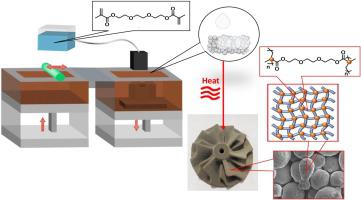Additive Manufacturing ( IF 11.0 ) Pub Date : 2020-05-25 , DOI: 10.1016/j.addma.2020.101341 Dustin Gilmer , Lu Han , Eunice Hong , Derek Siddel , Alexander Kisliuk , Shiwang Cheng , Dan Brunermer , Amy Elliott , Tomonori Saito

|
Additive Manufacturing (AM) of metals is a potentially disruptive technology that could significantly change the industrial supply chain. There are a limited number of AM methods capable of creating metal parts, and one method showing significant potential is Binder Jet AM (Binder Jetting). Binder Jetting utilizes an inkjet print head to deposit a binder fluid onto a powder bed and bind together powder particles into a desired geometry. This study investigates a new binder system consisting of a difunctional monomer, triethylene glycol dimethacrylate (TEG-DMA). TEG-DMA exhibits excellent printability with an Ohnesorge’s number of .258 making the Z number 3.876. During the thermal curing process, the difunctional monomer polymerizes and crosslinks at the onset temperature of 138 °C, becoming a solid dimethacrylate network. When the binder is utilized within the stainless-steel powder bed at 200 °C, it forms a network incorporating the stainless-steel particles, binding the powder into any specified geometry. Crosslinking the monomer within the stainless-steel 420 powder bed imparts a flexural strength of 1.0–3.3 MPa to the green part depending on the volume of monomer in the part. After sintering, the final stainless-steel parts results in a void fraction close to 60 % and carbon content below 0.4 %.
中文翻译:

用于粘结剂喷射添加剂制造的原位交联粘结剂
金属的增材制造(AM)是一种潜在的破坏性技术,可以极大地改变工业供应链。能够创建金属零件的AM方法数量有限,而具有显着潜力的一种方法是Binder Jet AM(Binder Jetting)。粘合剂喷射利用喷墨打印头将粘合剂流体沉积到粉末床上,并将粉末颗粒粘合在一起形成所需的几何形状。这项研究研究了一种由双官能单体三乙二醇二甲基丙烯酸酯(TEG-DMA)组成的新型粘合剂体系。TEG-DMA具有出色的可印刷性,Ohnesorge数为.258,Z值为3.876。在热固化过程中,双官能单体在起始温度138°C下聚合并交联,成为固态的二甲基丙烯酸酯网络。当粘合剂在200°C的不锈钢粉末床中使用时,它会形成包含不锈钢颗粒的网络,从而将粉末粘合成任何指定的几何形状。单体在420不锈钢粉末床中的交联赋予生坯部分以1.0-3.3 MPa的弯曲强度,具体取决于部件中单体的体积。烧结后,最终的不锈钢零件产生的空隙率接近60%,碳含量低于0.4%。


























 京公网安备 11010802027423号
京公网安备 11010802027423号